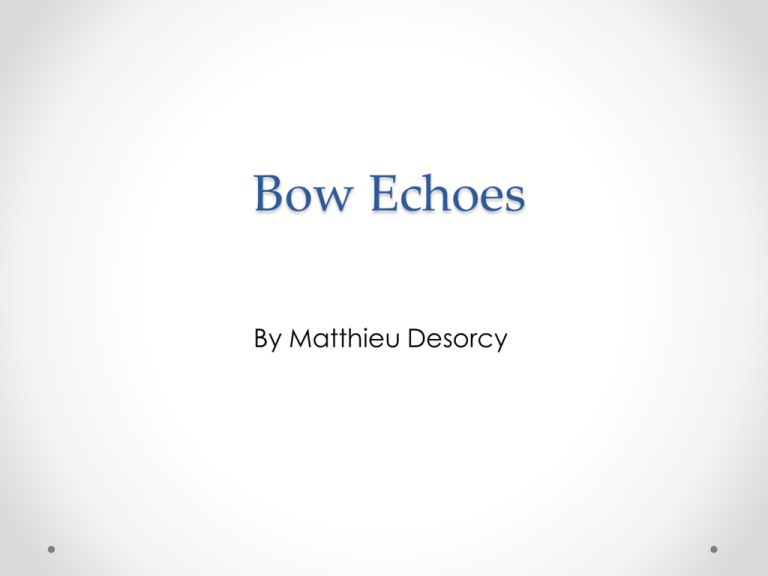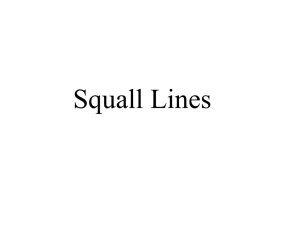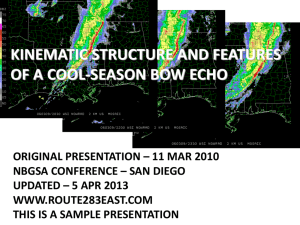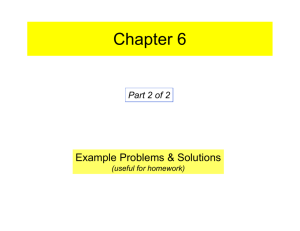Bow Echoes - Matthieu Desorcy
advertisement

Bow Echoes By Matthieu Desorcy What is a Bow Echo? • Bowing pattern on radar • Severe straight-line winds at the surface o Cause about 1/3 severe wind reports in US • Have a specific structure with rear-inflow jet reaching the surface • Originate from various storm modes • Typically need >2,000J/kg CAPE • Move quickly and accelerate http://www.crh.noaa.gov/dmx/?n=preparesvrintro Structure Note: • Strong rear inflow jet reaching the surface • Mid-level low pressure • Surface high pressure (by cold pool) • Most lift near leading edge of cold pool = strongest updrafts L H H Cross section taken from case-study of June 10, 2003 bow echo during near NE/IA border during BAMEX (Bow Echo and Mesoscale Convective Vortex Experiment) Initial Stages and Types • BE = classic bow echo • BEC = bow echo complex (bow echo with other storm type embedded, ie. supercell) • CBE = cell bow echo (small scale bow echo) • SLBE = squall line bow echo, also known as line echo wave pattern. Part of elongated linear convective system. Klimowski et al. 2004 Types (cont.) Klimowski et al. 2004 Kilmowski et al. Data and Summary • Used 273 scenarios between 1996-2003 in US • More squall line bow echoes as you head further east • Thunderstorm mergers likely to play a role in BE development consolidating cold pools, but need more data • Also suggests that when initial cell that merges with another, the speed and direction is maintained by BE • Average life span higher further south in the plains • CAPE and LLJ could be the reasoning for this – easier to get widespread high value CAPEs in the region and a strong lowlevel jet Mesovortices • Play a role in the production of straight-line winds and even tornadoes in bow echo events o Straight-line winds enhanced on south side of mesovortex because horizontal pressure gradient • Most often observed near the apex of the bow • Depends on the low level wind shear and strength (temperature contrast) of cold pool • Few to tens of kilometres in size • Observed while rear inflow jets are strengthening • Causes still under research Mesovortices (cont.) Note: • The location of the mesovortice, just north of the apex of the bow • The damaging part of the mesovortex (strongest straightline winds) is on the south side as it wraps around the descending rear inflow jet Nolan Atkins & St. Laurent 2009 Mesovortice Theories Theory 1: o Horizontal vorticity from downdraft gets tilted, stretched by updraft along gust front creating the vortice Theory 2: o Along the apex of bow echo stronger updrafts are produced (by either stronger downdrafts prior, or rear inflow jet) o Horizontal vorticity just behind gust front is tilted by the stronger updraft, which produces a cyclonic vortice just north of apex and anticyclonic one south of apex • Anticyclonic one not observed as much Mesovortice Theory 2 Nolan Atkins & St. Laurent 2009 Other Bow Echo Characteristics • Can have bookend vortices during mature stage – also caused by tilting of horizontal vorticity by updraft o Larger in scale than mesovortices • Bow echoes can become derechos if they have path >400km and meet wind criteria • Shelf clouds will typically be visible along gust front of bow echo http://en.wikipedia.org/wiki/Bow_echo#mediaviewer/File:Bow_ec ho_diagram.svg Bow Echo Summary • Produce strong winds, sometimes tornadoes • Rear inflow jet creates the strong winds • Bow echoes transition from other types of storms, some cases include cold pool consolidation • Can acquire characteristics that enhance tornado threat and winds locally (mesovortices) Questions? References: • Atkins, N. T & St. Laurent, M. (2009). Bow Echo Mesovortices. Part I: Processes That Influence Their Damaging Potential. Monthly Weather Review, 137, 1498-1513. doi:10.1175/2008MWR2649.1 • Atkins, N.T & St. Laurent, M. (2009, May). Bow Echo Mesovortices. Part II: Their Genesis. Monthly Weather Review, 137, 1514-1532. doi:10.1175/2008MWR2650.1 • Davis, C et al. (2014, August). The Bow Echo and MCV Experiment. BAMS, 1075-1093. doi:10.1175/BAMS-85-8-1075 • Klimowski, B. A et al. (2004, February). Radar Observations of the Early Evolution of Bow Echoes. Weather and Forecasting (AMS), 19, 727734.





